2022.12.01
The end of year period is a very important time for Japanese households as people try to clean up in readiness for the arrival of the Toshigami, or year gods, when they visit during the New Year period. Here are some of the customs your might see or even experience at this time of year.
Susuharai (煤払い)
 Also referred to as ōsōji (大掃除 / literally 'big clean up'), susuharai takes place in many households throughout Japan at the end of the year as occupants thoroughly clean their abode to remove the dust, grime and ill fortune that may have built up over the last year. Having the place spotless for the new year is thought to make it more welcoming to the Toshigami (年神), or 'year gods,' and it's best to not leave it to the last minute. Cleaning should be avoided on December 29, since the pronunciation of '9' (ku) is the same as 'suffering' (苦), and doing it any later is considered disrespectful. There are no ceremonies involved, just lots of cleaning. If you're expecting to have a lot of garbage to put out after you clean up, remember to check the year end collection schedule and plan accordingly.
Also referred to as ōsōji (大掃除 / literally 'big clean up'), susuharai takes place in many households throughout Japan at the end of the year as occupants thoroughly clean their abode to remove the dust, grime and ill fortune that may have built up over the last year. Having the place spotless for the new year is thought to make it more welcoming to the Toshigami (年神), or 'year gods,' and it's best to not leave it to the last minute. Cleaning should be avoided on December 29, since the pronunciation of '9' (ku) is the same as 'suffering' (苦), and doing it any later is considered disrespectful. There are no ceremonies involved, just lots of cleaning. If you're expecting to have a lot of garbage to put out after you clean up, remember to check the year end collection schedule and plan accordingly.
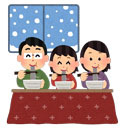 Toshikoshi Soba (年越し蕎麦)
Toshikoshi Soba (年越し蕎麦)
Toshikoshi soba (literally 'year-spanning soba noodles') is the name given to the soba (buckwheat) noodles many households partake in on Ōmisoka (大晦日 / New Year's Eve). The length of the noodles symbolizes longevity, and their softness compared to udon and other noodles means they break easily, just as people might hope to break ties with any ill fortune that has troubled them during the last year. Those who are not partial or might be allergic to soba can still take part by substituting another kind of noodle, even instant noodles.
 Joya no Kane (除夜の鐘)
Joya no Kane (除夜の鐘)
From New Year's Eve until early New Year's Day, the bell (鐘 / kane) at Buddhist temples is struck 108 times. This number is thought to reflect the 108 afflictions or negative emotions, which are exorcised by the striking of the bell so that people can begin the new year with a pure heart.
 Hatsuhinode (初日の出)
Hatsuhinode (初日の出)
The first sunrise of the year is considered to be especially auspicious, and many people get up before dawn on New Year's Day just to bear witness to the spectacle. Some people also make wishes for the coming year as they watch. Places offering an unfettered view of the horizon, such as tall buildings, towers, mountains and beaches have become popular hatsuhinode spots, and a number of airline companies offer special flights that allow passengers to see the sunrise regardless of the weather below.
O-Sechi (お節料理)
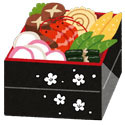 A collection of auspicious New Year's dishes, often presented in a layered box, and eaten over the course of the New Year celebrations. Each dish has a connection to the household's hopes and dreams for the new year, and the future. For example the pronunciation of kombu (昆布, kelp) resembles yorokobu (喜ぶ), meaning 'to be happy,' and kazunoko (数の子, herring roe, literally 'many children') signifies the hope to be blessed with children and grandchildren. Preparing the dishes can be a time-consuming affair, and some households prefer to partake in a small number of O-sechi dishes rather than spend time and money on a more extravagant box with items such as lobster. Busy households can order their O-sechi dishes online or from restaurants, department stores and convenience stores. The content of O-sechi has changed over time, and some now include fresh items such as sashimi, and Chinese and Western dishes to appeal to multiple generations.
A collection of auspicious New Year's dishes, often presented in a layered box, and eaten over the course of the New Year celebrations. Each dish has a connection to the household's hopes and dreams for the new year, and the future. For example the pronunciation of kombu (昆布, kelp) resembles yorokobu (喜ぶ), meaning 'to be happy,' and kazunoko (数の子, herring roe, literally 'many children') signifies the hope to be blessed with children and grandchildren. Preparing the dishes can be a time-consuming affair, and some households prefer to partake in a small number of O-sechi dishes rather than spend time and money on a more extravagant box with items such as lobster. Busy households can order their O-sechi dishes online or from restaurants, department stores and convenience stores. The content of O-sechi has changed over time, and some now include fresh items such as sashimi, and Chinese and Western dishes to appeal to multiple generations.
Decorations
・Kagamimochi (鏡餅)
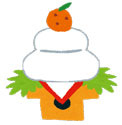 Literally 'mirror mochi (pounded rice cake),' this decoration is both an offering to and a receptacle for the Toshigami (年神), or 'year gods,' and traditionally consists of two different-sized flat round cakes of mochi, the smaller of which is placed on the larger, and topped with a bitter orange (Citrus aurantium). The flat, round shape of the mochi resembles that of bronze mirrors used in religious rites long ago, and is said to come from Yata no Kagami (八咫鏡), one of the Three Sacred Treasures of Japan. The crowning bitter orange (often substituted with a mandarin) is said to represent another of the Sacred Treasures, the Yasakani no Magatama (八尺瓊勾玉) curved jewel. Kagamimochi is generally displayed inside the home (traditionally in the alcove of a Japanese-style room, or an inner room far from the entrance) from around December 28 until the Kagami biraki (鏡開き, 'Opening of the mirror') of January 11, when the mochi is eaten. Plastic-encased kagamimochi, sometimes with a plastic orange accessory, are sold at supermarkets at the end of the year.
Literally 'mirror mochi (pounded rice cake),' this decoration is both an offering to and a receptacle for the Toshigami (年神), or 'year gods,' and traditionally consists of two different-sized flat round cakes of mochi, the smaller of which is placed on the larger, and topped with a bitter orange (Citrus aurantium). The flat, round shape of the mochi resembles that of bronze mirrors used in religious rites long ago, and is said to come from Yata no Kagami (八咫鏡), one of the Three Sacred Treasures of Japan. The crowning bitter orange (often substituted with a mandarin) is said to represent another of the Sacred Treasures, the Yasakani no Magatama (八尺瓊勾玉) curved jewel. Kagamimochi is generally displayed inside the home (traditionally in the alcove of a Japanese-style room, or an inner room far from the entrance) from around December 28 until the Kagami biraki (鏡開き, 'Opening of the mirror') of January 11, when the mochi is eaten. Plastic-encased kagamimochi, sometimes with a plastic orange accessory, are sold at supermarkets at the end of the year.
・Shimekazari (注連飾り)
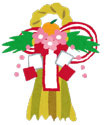 Shimekazari are domestic variations on the shimenawa (注連縄, the rice or hemp straw rope decorations used to delineate sacred spaces at shrines and around sacred objects such as trees and rocks), placed at the entrance to welcome the Toshigami into the home. Shimekazari are sold at various stores including department stores, home and hardware stores, convenience stores and 100-yen stores, and are generally put up around December 28 and taken down on January 7, after a breakfast of traditional Nanakusa-gayu (七草粥, literally 'seven grass rice porridge,' eaten to ward against illness and ill fortune over the coming year).
Shimekazari are domestic variations on the shimenawa (注連縄, the rice or hemp straw rope decorations used to delineate sacred spaces at shrines and around sacred objects such as trees and rocks), placed at the entrance to welcome the Toshigami into the home. Shimekazari are sold at various stores including department stores, home and hardware stores, convenience stores and 100-yen stores, and are generally put up around December 28 and taken down on January 7, after a breakfast of traditional Nanakusa-gayu (七草粥, literally 'seven grass rice porridge,' eaten to ward against illness and ill fortune over the coming year).
Hatsumōde (初詣)
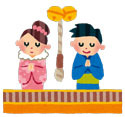 Hatsumōde is the custom of visiting a shrine or temple early in the New Year to pray for good fortune in the year to come. Although some people head out to pray as the bell is struck at midnight and the new year begins, most people will make their visit during the first few days of January. Hatsumōde can be performed at any shrine or temple, even the little quiet one in your neighborhood. If you visit a small local shrine after midnight on January 1, you may find parishioners offering sake, snacks, and amazake (甘酒, a sweet drink made from fermented rice) to visitors, and a bonfire (a welcome sight in the cold of night) where you can dispose of any talismans from the previous year.
Hatsumōde is the custom of visiting a shrine or temple early in the New Year to pray for good fortune in the year to come. Although some people head out to pray as the bell is struck at midnight and the new year begins, most people will make their visit during the first few days of January. Hatsumōde can be performed at any shrine or temple, even the little quiet one in your neighborhood. If you visit a small local shrine after midnight on January 1, you may find parishioners offering sake, snacks, and amazake (甘酒, a sweet drink made from fermented rice) to visitors, and a bonfire (a welcome sight in the cold of night) where you can dispose of any talismans from the previous year.
O-Toshidama (お年玉)
 As relatives gather to celebrate the new year, it's customary to give each child a small paper envelope with money inside, known as O-toshidama. Although in former times it was acceptable to give children mochi or sweets, this changed with the increase in incomes during the period of high economic growth from the 1950s to 1970s. Although there is no clear rule on how much to give, many people vary the amount according to the child's age. If you expect to go to a gathering where children will be present on New Year's Day, it's a good idea to find out how many children will be there, and prepare accordingly. O-toshidama envelopes are available at stationery and toy stores. Remember that any notes should be new and uncreased (although some folding is required to put notes in the little envelopes), and amounts such as 400 Yen, 4,000 Yen are to be avoided as the number 4 is associated with death ('4' and '死' can both be read as 'shi' - 'death').
As relatives gather to celebrate the new year, it's customary to give each child a small paper envelope with money inside, known as O-toshidama. Although in former times it was acceptable to give children mochi or sweets, this changed with the increase in incomes during the period of high economic growth from the 1950s to 1970s. Although there is no clear rule on how much to give, many people vary the amount according to the child's age. If you expect to go to a gathering where children will be present on New Year's Day, it's a good idea to find out how many children will be there, and prepare accordingly. O-toshidama envelopes are available at stationery and toy stores. Remember that any notes should be new and uncreased (although some folding is required to put notes in the little envelopes), and amounts such as 400 Yen, 4,000 Yen are to be avoided as the number 4 is associated with death ('4' and '死' can both be read as 'shi' - 'death').




